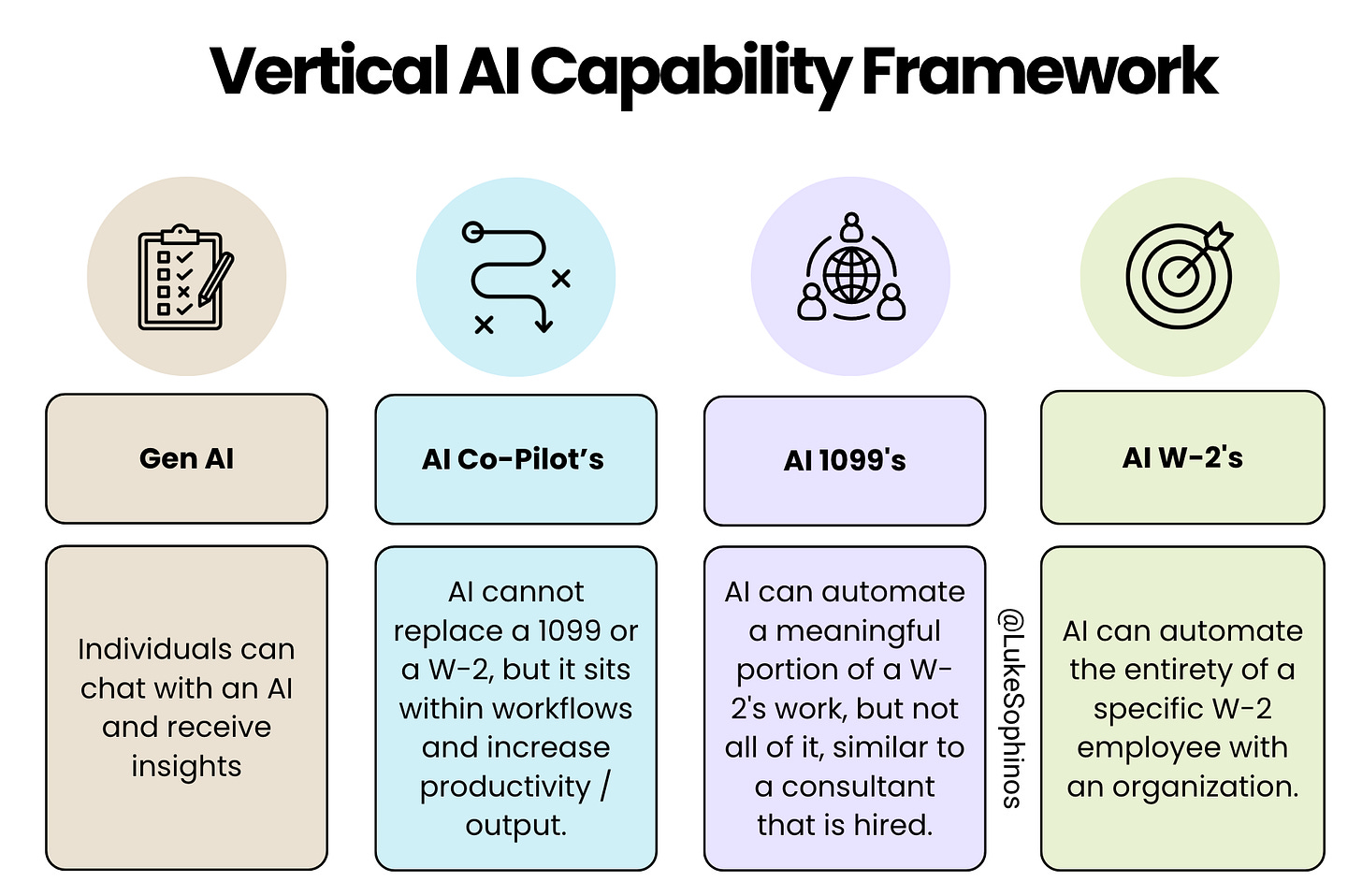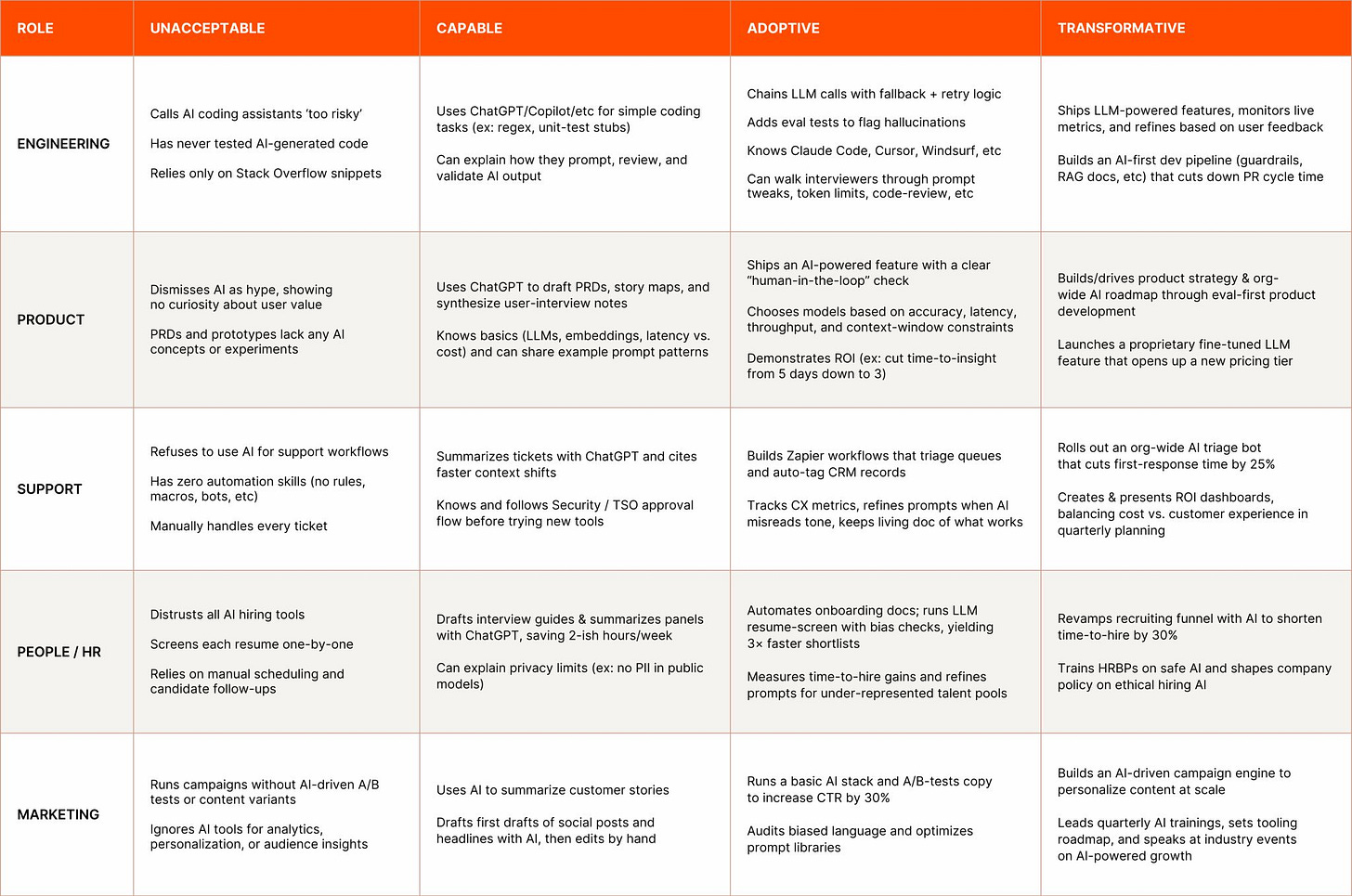#132: The Vertical AI Framework + Playbook, How To Ensure Your Employees Are AI Fluent
One vSaaS breakdown. One biz story. One 'how to'. In your inbox once a week.
Today's newsletter is sponsored by Rainforest, the embedded payment provider purpose-built for vertical software platforms.
Grow revenue with the only payfac-as-a-service provider optimized to help you drive more payments volume at higher margins, without risk or compliance headaches.
Learn more at rainforestpay.com
Alright, let’s get to it…
One vSaaS Breakdown:
Vertical AI Framework + Playbook:
Gen AI, AI Co-Pilot, AI 1099, or AI W-2?
The level of AI marketing speak has achieved a whole new paradigm.
Nearly every AI tool is promising complete headcount removal when in reality, one out of a hundred products I see can actually achieve this today. That doesn’t mean they won’t achieve it tomorrow, or with the next big AI upgrade, but with TODAY’S AI, it is truly far and few between.
I think it’s important for every start-up to set the proper expectations and balance an exciting new technology with what it can actually achieve TODAY, and what you expect it to achieve TOMORROW.
The framework for this I’m using is the below, and I think it’d be helpful if we all talked about our products, to investors/employees/OR customers, with this or something similar so they can actually understand what our tool is providing.
Of course we all want complete headcount automation, but getting there is a process. VC’s and customers don’t expect you to be there right away. So overpromising is dangerous, especially when you can still deliver a great SaaS-esque ROI with talking about full headcount removal coming as AI levels up.
Another thing that’s important to note — I’m seeing Gen AI products grow SIGNIFICANTLY faster than the latter three categories.
Why? Well because they typically don’t require integration, they are incredibly easy to implement, and people are already use to how these work (ala ChatGPT).
Let’s look at Abridge as a good case study here.
Abridge started as the SAME interface as ChatGPT but the LLM was solely trained on medical data, versus horizontal tools being trained on (basically) the entire open internet.
Hospitals had to act fast, because they didn’t want their clinicians putting sensitive data into ChatGPT, Claude, etc.
The result? Absolute hypergrowth.
You don’t raise this amount of capital this fast without it:
Abridge has now expanded into leveraging that data to offer AI Co-Pilot products and I’m sure will continue to more and more complete workflow automation.
Abridge never promised complete W-2 automation. Will they get there? Yeah, probably. But it is SO MUCH easier to get there now that they have a zillon hospitals on their platform and all their data.
I think achieving market scale with a Gen AI product is the new wedge. From there you can move to more and more automation until you can offer complete AI W-2’s.
There is going to be a lot of exciting embedded tooling you can do after this (think payments, insurance, credit, etc. that are all taken care of / processed by an agent).
Damn. Did we all just stumble upon something big?
This might just be the new Vertical AI playbook…
Starting with AI W-2’s is like starting with the ERP. The product probably sucks or feels like vapor ware. It’s too complex, you’re just going to miss a lot.
I’ve experienced this with a lot of these AI SDR tools. Completely overhyped.
Build into it over time. Just like the classic vSaaS playbook → start with the wedge, prove your value, and then expand, expand, expand.
Before you know it you’ll own a market. And that market will be worth WAY MORE in the AI era than it was in the SaaS era.
One Biz Story:
Hear founding stories from billion dollar vSaaS founders at the the vSaaS Summit !
(<50 seats left)
I think we will sell out in the next ~60-90 days!
(vSaaS founders/operators/investors only).
One ‘How To’:
How To Ensure Your Employees Are AI Fluent
If you haven’t had your “aha” moment with AI you are behind the ball.
If you know key folks at your company have not had their “aha” moment with AI, your company is behind the ball.
What do I mean by “aha” moment?
When you use a product or service and you are so dazzled by it that you realize there is never any going back.
Think about the first time you used Uber, or maybe the first time you ordered something online and it was at your doorstep the next day. You can think of a time or two when you felt this. It was the, “Wow. This is incredible and I can’t believe this exists.”
That’s where we are with AI today. I genuinely think that you are risking the future of your business if you are not actively using these tools. This stuff is CRAZY powerful and makes EVERY ONE, regardless of their job, more productive.
And I DON’T mean using it for some writing here and there. I mean actually using it for real work that you do. Actually deploying real AI agents.
So if you’re not actively pushing your company and the people within it, it is time to seriously consider doing so.
I studied how Zapier did it, so you all can take the learnings into your business. If you want to go deeper, you can read their CEO’s full blog post here.
So how do we ACTUALLY get our company and employees bought-in and using AI?
Zapier transformed AI into a cornerstone of its operations, achieving 89% team adoption in two years. Here’s a condensed guide to their approach and actionable steps for your company, with key takeaways.
Leadership-Driven Urgency: Zapier’s CEO launched a “Code Red,” signaling AI as a non-negotiable priority. This bold move unified the company, even if it sparked initial resistance. To replicate this, your leadership must champion AI as a strategic imperative. Communicate its urgency in town halls, emails, and one-on-ones, tying it to business survival and growth. For example, highlight how AI can cut costs or unlock new revenue streams.
Hands-On Engagement: Zapier kicked off with a week-long AI Hackathon, involving all teams—engineers, marketers, HR, and support. Employees experimented with tools like OpenAI, building prototypes and sparking ideas. At your company, organize a similar event. Provide access to AI platforms (e.g., ChatGPT, Google Gemini), offer tutorials, and set clear goals, like automating a repetitive task. Include non-technical staff to broaden participation and demystify AI.
Cultural Reinforcement: Zapier didn’t rely on a single announcement. They embedded AI into all-hands meetings, Slack channels, and quarterly hack weeks, normalizing its use. To do this, integrate AI discussions into your company’s rhythm. Share success stories—like how AI reduced response times in customer support—via internal newsletters or dashboards. Create a dedicated Slack channel for AI tips and wins, encouraging cross-team sharing.
Safe Experimentation: Zapier tolerated messy experiments, like early OpenAI plugins that failed but inspired better solutions. They built infrastructure for compliance and safety, enabling bold yet secure innovation. Your company should establish guardrails, such as data privacy protocols and approved AI tools, to foster experimentation. Encourage small-scale pilots, like using AI for email drafting or data analysis, and celebrate learnings from failures. Zapier’s 2025 Model Context Protocol (MCP) scaled this approach; you can start with a simple framework for testing and iterating AI use cases.
Distributed AI Adoption: Every Zapier team adopted AI, from support automating responses to HR streamlining onboarding. This broad usage maximized impact. At your company, identify one AI use case per department. For example, marketing can use AI for content ideation, while finance can automate expense categorization. Provide training tailored to each team’s needs, ensuring everyone sees AI’s relevance.
Reimagining Workflows: Zapier used AI to tackle previously unfeasible tasks, like complex data processing, reducing hiring needs and boosting efficiency. Encourage your teams to rethink workflows. Ask, “What tasks are too slow or costly?” Use AI to automate or enhance these, such as generating real-time sales reports or personalizing customer outreach at scale.
Implementation Steps:
Week 1: Leadership announces AI as a priority, tying it to business goals.
Month 1: Host an AI Hackathon, providing tools and training.
Quarter 1: Set up compliance frameworks and pilot AI in 2-3 departments.
Ongoing: Require all departments to leverage AI for at least a few workflows. Share successes monthly, refine use cases, and reward expansion.
Implement your version of Zapier’s “How do we measure AI fluency?” and require managers to track/measure on it during performance reviews.
Have a product or service that would be great for our audience of vertical SaaS founders/operators/investors? Reply to this email or shoot us a note at ls@lukesophinos.com







